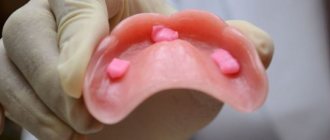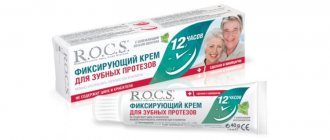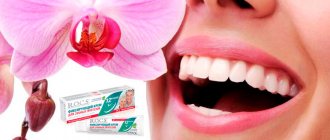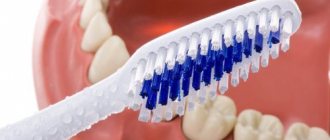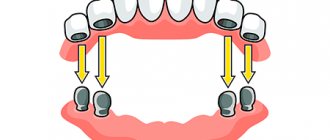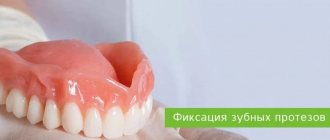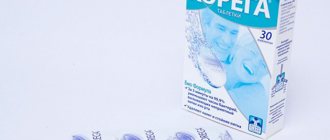Old front-line doctors knew that it was diseased teeth that most often lead to chronic gastrointestinal diseases. However, many modern people increasingly have to replace their natural teeth with artificial dentures. And, according to scientists, the number of people with such tooth replacements is increasing every year. Let us find out together what fixation of dentures is and how it is carried out.
Causes of tooth loss
Most often, removable orthodontic structures are installed when several teeth are lost. Sometimes congenital malformations lead to missing teeth. But more often the following reasons lead to their loss:
- consequences of dental disease (caries, periodontitis, etc.);
- jaw injuries;
- taking narcotic substances (pervitin, etc.)
Loss of teeth leads to such serious problems as speech impairment, deterioration in chewing food, and excessive stress on the remaining teeth with consequences such as their loosening and loss.
Often, the absence of teeth leads to psychological problems that prevent a person from realizing himself in many areas.
But thanks to the achievements of modern dentistry, missing teeth are now very effectively replaced with artificial dentures. Modern dental structures are ideally similar in appearance and functional properties to natural teeth; they are durable and comfortable.
Partial removable structures
If several units are missing in a row and it is impossible to make an implantation, partial removable dental prosthetics are used. The following structures can be used for this:
- Lamellar. They are fixed on the supporting teeth with metal hooks.
- Clasp on a metal frame. Such dentures are attached in three ways - on clasps, attachments or telescopic crowns.
- Quadrotti clasp plastic systems (QuattroTi). Fixation is carried out on the supporting teeth with aesthetic clasps made of durable polymer material Dental-D.
- Sandwich dentures. These structures are literally placed over the supporting teeth using large, hollow crowns.
Fixation of dentures: methods and convenience
The convenience of using a denture largely depends on correct fixation.
To achieve this, orthodontists try to achieve maximum compliance of the inner surface of the prosthesis with the shape of the patient’s alveolar process. As a rule, such structures usually have special fixing elements. However, they cope with the problem of fixing the prosthesis at rest. But when chewing or talking, the structure may fail due to increased load. Therefore, for better fixation of such devices, special means are used.
Depending on how many teeth a person is missing, doctors recommend the installation of full or partial dental restorations. Removable structures are mainly made of plastic in combination with other materials. Each type of such devices has its own characteristics of fixation. In addition to clasps (or brackets) and attachments (clasps), special means are used to secure dental structures, presented in the form of:
- cream or gel;
- glue;
- stripes;
- powder.
Fixatives are usually made from plant or animal products. They are saturated with saliva and increase in volume, forming a layer between the plastic base and the mucous membrane that provides high adhesion force for the prosthesis.
Also, fixation means prevent food debris from getting under the prosthesis, and also facilitate the process of adaptation to the prosthesis and tissue healing after its installation.
No. 2 in the ranking cream for fixing dentures Lacalut
Photo: zubizub.com
Price from 270 to 400 rubles.
Rating – 9.8
High quality cream, produced by a German company. According to the manufacturer, when using the product, reliable fixation is ensured for at least 24 hours. Creates a thin layer between the prosthesis and soft tissues, protecting them from mechanical damage by the edge of the prosthesis, which helps adapt to a removable structure worn for the first time.
From reviews : Ivan Arsentievich, 48 years old - “Due to an injury, I lost two front teeth, the dentist made a temporary removable denture, which held up very poorly. At the pharmacy, the pharmacist advised me to buy Lacalut cream, and I am completely satisfied with the result.”
Pros:
- reliable fixation;
- pleasant taste and smell;
- thanks to the thin film created when using the cream, it protects soft tissues from chafing.
Minuses:
- high price;
- fixation is slightly weakened by consuming hot foods and drinks (especially tea and coffee).
Creams and gels
Fixing a denture with cream or gel, which to choose? Both of these remedies are identical in their effectiveness and method of use. The only difference between them is the greater fluidity of the gels with the ability to form a thinner layer. Creams have a denser consistency and contain an additive of aromatic oils.
Rules for the use of gels and creams for dentures
Typically, experts recommend using creams to fix dentures immediately after prosthetics because of their ease of dosing and use.
But the amount of gel is more difficult to correctly calculate. If you increase its amount, the gel will not harden and hold the prosthesis normally.
Creams are applied to the lower segment of the denture, which is then pressed firmly against the gums. The creams reliably fix the structure for 12-24 hours.
The cream is especially recommended for patients with excessive salivation.
The most common and high-quality fixation creams are Rocs, Lacalut, Protefix, President, Corega, etc.
To choose the right means of fixation, you need to know such subtleties
- It is better to choose gels and creams with neutral scents. Fragrances in them are contraindicated for people with allergies.
- Preference should be given to waterproof products due to their longer action and better tightness. Waterproof types of compositions better protect against the penetration of food under the prosthesis and the development of unpleasant odors or inflammation.
- It is better to avoid using products containing zinc due to its toxic effect on the body (nervous and skeletal systems).
- Products with a gel-like consistency are more economical due to the ability to form a thinner layer during fixation.
Contraindications and side effects of fixing agents
Fixing agents are contraindicated for use in the presence of hypersensitivity to their components. Also, they should not be used in the presence of acute dental inflammatory diseases, side effects, or expiration date.
You should choose products without zinc, since it has a negative effect on the body, has a toxic effect and can cause neurological pathologies. Other side effects - weakness, headache, stomach pain - can occur with excessive use of fixation devices.
Category Medicines / drugs Published by Mister stomatolog
Fixing strips
A remedy such as fixing strips is more often used for various malocclusion pathologies.
In addition, strips are useful if it is difficult to get used to dentures. They are made from a special material that ensures good fixation of removable structures. Additionally, the strips also protect the gums from damage. This product is very easy to use. Usually, for good fixation, the strip is immersed in warm water for a few seconds. Then it is applied to the prosthesis and inserted into the mouth together with it.
No. 4 in the ranking cream for fixing prostheses Fittident
Photo: harkov.promoz.com.ua
Price from 180 to 250 rubles.
Rating – 9.5
One of the best creams for dentures, but when using Fittident, people with highly sensitive gums feel a rather strong burning or tingling sensation. To avoid this effect, you need to let the cream dry on the prosthesis for at least 20-30 seconds. If there is increased saliva production, you can apply a larger amount of cream, which is then removed with a dry cloth until it hardens.
From reviews : Maria Fillipovna, 61 years old – “My daughter bought me Fittident cream; before that I used other products that did not provide good attachment. Now the prosthesis does not even have to be removed at night, it simply does not come off (even while eating). Completely satisfied."
Pros:
- when removing the denture, no traces of cream remain on the gums;
- has no pronounced taste;
- fixes the prosthesis for a long time.
Minuses:
- has a rather viscous consistency;
- can only be applied to a dry prosthesis;
- difficult to buy in pharmacies (only in big cities or in online stores).
Glue
Denture adhesive acts as a soft cushion to cushion movement between the jaw and the structure during chewing. It is used for fastening both removable and permanent dentures (fixing a crown, temporarily strengthening a tooth or a broken bridge).
Adhesives are usually water-based.
The disadvantage of this product is associated with the gradual dissolution of the components and loss of effectiveness of the composition.
Excess glue can irritate your gums. The most commonly used glue is from Protefix, Corega, and Fittident.
Indications for the use of fixing materials
Many people ask whether it is always necessary to use additional means to fix dentures? Most often, such means are used:
- for the reliability of using the prosthesis (to facilitate biting and chewing food, to eliminate the fear of losing the prosthesis when speaking);
- people whose profession involves increased demands on appearance or voice (teachers, musicians, speakers);
- with dry mouth due to diseases (stroke, etc.) or taking certain medications, in elderly patients.
Fixation of dentures in complete absence of teeth
The absence of teeth (complete edentia) does not allow a person to grind food when chewing. A toothless mouth leads to a violation of facial proportions (sunken mouth), defects in diction, the emergence of severe self-doubt and the inability to lead a full lifestyle.
Modern dentistry allows us to solve this problem with the help of fixed and removable structures. Most people, for various reasons (usually financial), use removable orthodontic structures in such cases. Often, problems arise related to the impossibility of their reliable fixation, even to the point of the prosthesis falling out at the most inopportune moments.
Most often, in case of complete absence of teeth, removable structures made of acrylic plastic are used. Typically, glue, cream or gel is used to fix them.
For many patients, nylon bridges are attached using a flexible backing. This method of fastening is convenient and safe for patients, as it allows the prosthesis to be firmly attached to the mouth.
How to properly fix a complete denture
To properly fix a denture in the absence of teeth, you must adhere to the following rules:
- Thoroughly clean the gums and the denture itself.
- Apply a little product evenly to the recesses in the structure.
- Put on the denture and press it firmly against the gums for 5 seconds.
- Refrain from eating and drinking for 5 minutes.
- If it contains a zinc fixative, the product should not be used more than once a day. In this case, you should immediately pay attention to any ailments such as nausea, vomiting, headache or weakness.
Your prosthetist can best tell you which product is best to use for fixing removable dental structures. Sometimes patients have to use several products until they can find the most suitable fixative for themselves.
Sources used:
- “Removable dentures: a textbook” (Mironova M.L.)
- “Partial removable dentures” (Zhulev E.N.)
- Complications during dental prosthetics and their prevention / M.G. Bhushan, H.A. Kalamkarov. — M.: Shtintsa
No. 3 in the ranking cream for fixing dentures Protefix
Photo: www.queisser.ru
Price from 280 to 400 rubles (cream in 24 gram tubes costs from 140 rubles).
Rating – 9.6
Products from the Protefix series ensure reliable attachment of the prosthesis to the gum tissue for at least 10-12 hours. There are three varieties of this product: hypoallergenic cream, which, due to the absence of dyes and fragrances, causes fewer allergic reactions; as well as creams containing mint or aloe components.
From reviews : Anna, 29 years old - “I persuaded my mother to put in a clasp prosthesis, but she opted for a nylon one, which is quite poorly fixed in the mouth. The doctor advised me to use Protefix fixation cream, now my mother can calmly eat and talk without fear that her teeth will end up on the floor at the most crucial moment.”
Pros:
- economical;
- has high fixing properties;
- has no taste or smell.
Minuses:
- the cream tube contains a significant percentage of liquid;
- slightly inconvenient dispenser;
- The bottle must be tightly closed and stored in an upright position, as the product may leak.


